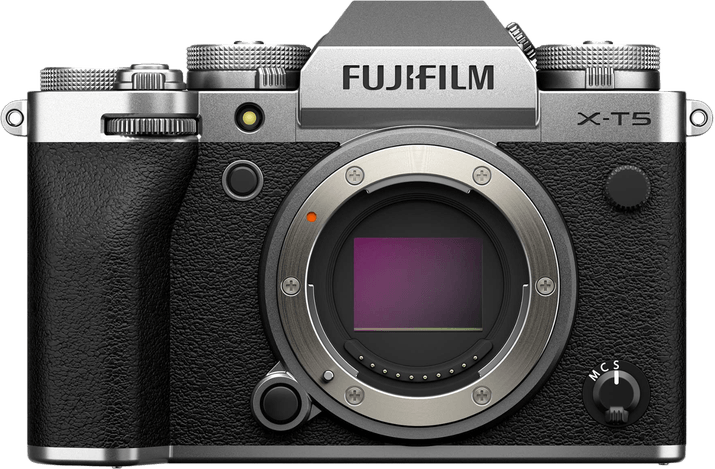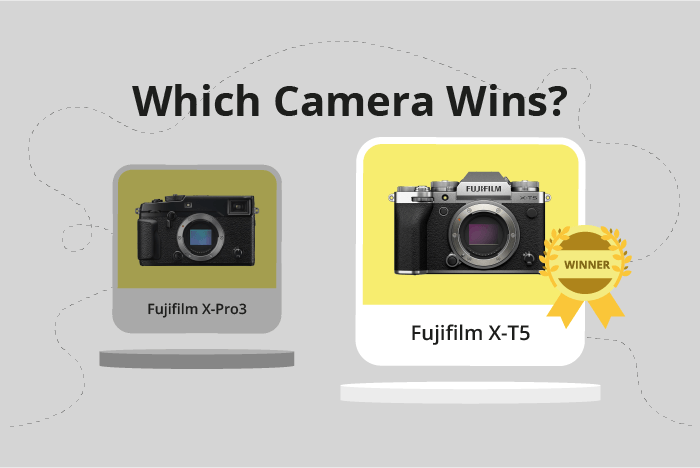Fujifilm X-Pro3 vs X-T5 Comparison
Fujifilm X-Pro3

Fujifilm X-T5

The Fujifilm X-T5 emerges as the winner with a score of 81/100, while the Fujifilm X-Pro3 trails behind at 72/100. Both cameras share similarities, being mirrorless and produced by Fujifilm.
The X-T5 outshines the X-Pro3 in several aspects. Despite being released more recently in 2022, the X-T5 has a lower launch price of $1699 compared to the X-Pro3’s $1799 price tag from 2019. This makes the X-T5 a more budget-friendly option.
The X-Pro3, however, is lighter at 497g (1.10lbs) and has a more compact size (141 x 83 x 46mm) than the X-T5, which weighs 557g (1.23lbs) and measures 130 x 91 x 64mm. This makes the X-Pro3 more portable and easier to carry around.
Taking all factors into consideration, the Fujifilm X-T5 offers better value for money due to its higher score and lower price. Meanwhile, the Fujifilm X-Pro3 is ideal for those who prioritize portability and a compact design.
Fujifilm X-Pro3 vs X-T5 Overview and Optics
The Fujifilm X-T5 outperforms the Fujifilm X-Pro3 in optics with a score of 81/100 compared to the X-Pro3’s 67/100. Both cameras share some common specifications, such as the CMOS sensor type, APS-C sensor size, and the Fujifilm X lens mount. Despite these similarities, there are key differences that make the X-T5 a superior choice in terms of optics.
The X-T5 has a higher megapixel count at 40, which allows for better image resolution compared to the X-Pro3’s 26 megapixels. This means the X-T5 captures more detail and produces higher quality images. Additionally, the X-T5 has a faster shooting speed of 15 frames per second (fps), compared to the X-Pro3’s 11 fps. This faster speed allows for improved performance when capturing fast-moving subjects or shooting in burst mode.
Another advantage of the X-T5 is its image stabilization feature, which the X-Pro3 lacks. Image stabilization helps to reduce camera shake and blurry images, especially when shooting handheld or in low light conditions. This feature further enhances the X-T5’s performance and versatility.
While the X-Pro3 may not excel in optics compared to the X-T5, it still delivers quality images with its 26-megapixel sensor and 11 fps shooting speed. However, the absence of image stabilization makes it less versatile and suitable for certain shooting conditions.
Considering the differences in optics, the Fujifilm X-T5 stands as the better choice for photographers seeking higher resolution images, faster shooting speeds, and image stabilization. While the X-Pro3 still offers good performance, the X-T5’s superior optics make it the more versatile option for various photography scenarios.
Fujifilm X-Pro3 vs X-T5 Video Performance
The Fujifilm X-Pro3 emerges as the winner in the video capabilities comparison with a score of 91/100, while the Fujifilm X-T5 trails behind with a score of 87/100. Both cameras share some common specifications, including time-lapse functionality built in, providing users with the ability to create stunning time-lapse videos effortlessly.
The X-Pro3 excels in video performance primarily due to its higher maximum video frame rate of 120fps, compared to the X-T5’s 60fps. This enables the X-Pro3 to capture smoother slow-motion footage and provides more flexibility for videographers during post-production. The camera also boasts a 4K maximum video resolution with dimensions of 4096 x 2160, ensuring high-quality video output.
On the other hand, the X-T5 surpasses the X-Pro3 in terms of maximum video resolution, offering an impressive 6K resolution with dimensions of 6240 x 4160. This higher resolution allows for more detailed footage and greater flexibility during post-production, such as cropping or zooming without losing quality. However, the lower maximum frame rate of 60fps may limit its slow-motion capabilities.
Taking these factors into account, the Fujifilm X-Pro3 is the superior choice for videographers seeking smoother slow-motion footage and a balance between resolution and frame rate. The Fujifilm X-T5, with its higher resolution, may appeal to those prioritizing detail and post-production flexibility over slow-motion capabilities. Each camera has its unique strengths, and the ideal choice will depend on the specific needs and preferences of the user.
Fujifilm X-Pro3 vs X-T5 Features and Benefits
The Fujifilm X-Pro3 and the Fujifilm X-T5 both score 85/100 in features, making them equal in this aspect. However, there are some differences between the two cameras that may affect a buyer’s decision.
Both cameras have a 3-inch screen, touchscreen capabilities, flip screens, and lack GPS. They also both have WIFI and Bluetooth capabilities. These common features make them quite similar in terms of usability and connectivity.
The X-Pro3 has a screen resolution of 1,620,000 dots, while the X-T5 has a marginally better screen resolution of 1,840,000 dots. This means that the X-T5 provides a slightly clearer and sharper display, which can be helpful for photographers when reviewing their shots or navigating the camera’s settings.
On the other hand, the X-Pro3 does not have any distinct advantages over the X-T5 in terms of features. Both cameras are on par with each other, making the choice between them more dependent on other factors, such as design, price, or personal preference.
In conclusion, the Fujifilm X-Pro3 and the Fujifilm X-T5 are evenly matched in terms of features. The X-T5 has a slightly better screen resolution, but this difference may not be significant enough to sway a buyer’s decision. Ultimately, the choice between these two cameras will depend on factors beyond their features, such as individual needs and preferences.
Fujifilm X-Pro3 vs X-T5 Storage and Battery
The Fujifilm X-T5 emerges as the winner in the storage and battery category with a score of 76/100, compared to the Fujifilm X-Pro3’s score of 71/100. Both cameras have two memory card slots and accept SD, SDHC, and SDXC cards. They also both support USB charging.
The X-T5 outperforms the X-Pro3 in battery life, offering 580 shots compared to the X-Pro3’s 400 shots. The X-T5 uses the NP-W235 battery type, which contributes to its longer battery life. On the other hand, the X-Pro3 has the advantage of being compatible with UHS-II memory cards, providing faster read and write speeds than the UHS-I cards used by the X-T5.
In terms of storage and battery, the Fujifilm X-T5 is the better choice due to its longer battery life. However, the X-Pro3’s UHS-II compatibility may be a deciding factor for those who prioritize faster memory card performance.
Fujifilm X-Pro3 vs X-T5 – Our Verdict
Are you still undecided about which camera is right for you? Have a look at these popular comparisons that feature the Fujifilm X-Pro3 or the Fujifilm X-T5:

